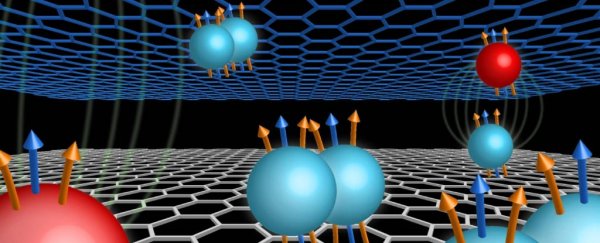The super-thin 'wonder material' graphene has been shaking up science for years with its amazing properties, but things get really interesting when you stack this 2D nanomaterial up against itself.
In new experiments, physicists in the US have found that when graphene is assembled in a double-layer vertical stack – with two adjacent sheets of the material that are almost touching – the proximity produces quantum states that haven't been observed before.
These newly measured states, resulting from complex interactions of electrons between the two graphene layers, are examples of what's called the fractional quantum Hall effect – and it's just the latest example of how physical science gets weird when materials effectively only occupy two dimensions.
"The findings show that stacking 2D materials together in close proximity generates entirely new physics," says physicist Jia Li from Brown University.
"In terms of materials engineering, this work shows that these layered systems could be viable in creating new types of electronic devices that take advantage of these new quantum Hall states."
The roots of the new discovery trace back some 140 years, to when scientists first discovered what became known as the Hall effect: the way that voltage can be deflected by the presence of a magnetic field.
This so-called Hall voltage runs in the transverse direction as a result of the Hall effect, which is amplified if the magnetic field being applied becomes stronger.
About a century later, physicists observed a related phenomenon, the quantum Hall effect, which is seen in two-dimensional electron systems – including more recently developed 2D nanomaterials, such as graphene.
In the quantum version of the effect, it was seen that the way the Hall effect becomes amplified due to stronger magnetic fields wasn't a smooth, linear increase: instead, the Hall conductivity was quantised – jumping to new, fixed plateaus, much like a staircase.
Subsequent experiments revealed some of these phenomena could be explained by fractional numbers – the aforementioned fractional quantum Hall effect (FQHE). Li's team has now observed new kinds of FQHE in their study.
"Once again the incredible versatility of graphene has allowed us to push the boundaries of device structures beyond what was previously possible," says one of the team, physicist Cory Dean from Columbia University.
"The precision and tunability with which we can make these devices is now allowing us to explore an entire realm of physics that was just recently thought to be totally inaccessible."
In the new work, the two graphene layers were separated by a thin layer of hexagonal boron nitride, which was inserted to act as an insulating barrier. The device was also surrounded by hexagonal boron nitride, and connected to graphite electrodes.
By subjecting this assembly to extremely strong magnetic fields – millions of times stronger than Earth's magnetic field – the team observed never-before-seen FQHE states in the way electrons interacted between the graphene layers.
While these intriguing states are new to science, they do seem to accord for the most part with our existing understanding of quasiparticles called composite fermions – a quantised phenomenon first discovered in FQHE research.
But the new findings suggest there might be more to these composite fermions (CFs) than we thought.
"Apart from the interlayer composite fermions, we observed other features that cannot be explained within the composite fermion model," says physicist Qianhui Shi from Columbia University.
"A more careful study revealed that, to our surprise, these new states result from pairing between composite fermions."
While there's a lot more research to be done before we understand the full implications, the team says they "interpret these states to result from residual pairing interactions between CFs, representing a new type of correlated ground state that is unique to graphene double-layer structures and not described by the conventional CF model."
In other words, one graphene layer is good, but two are out of this world.
The findings are reported in Nature Physics.
